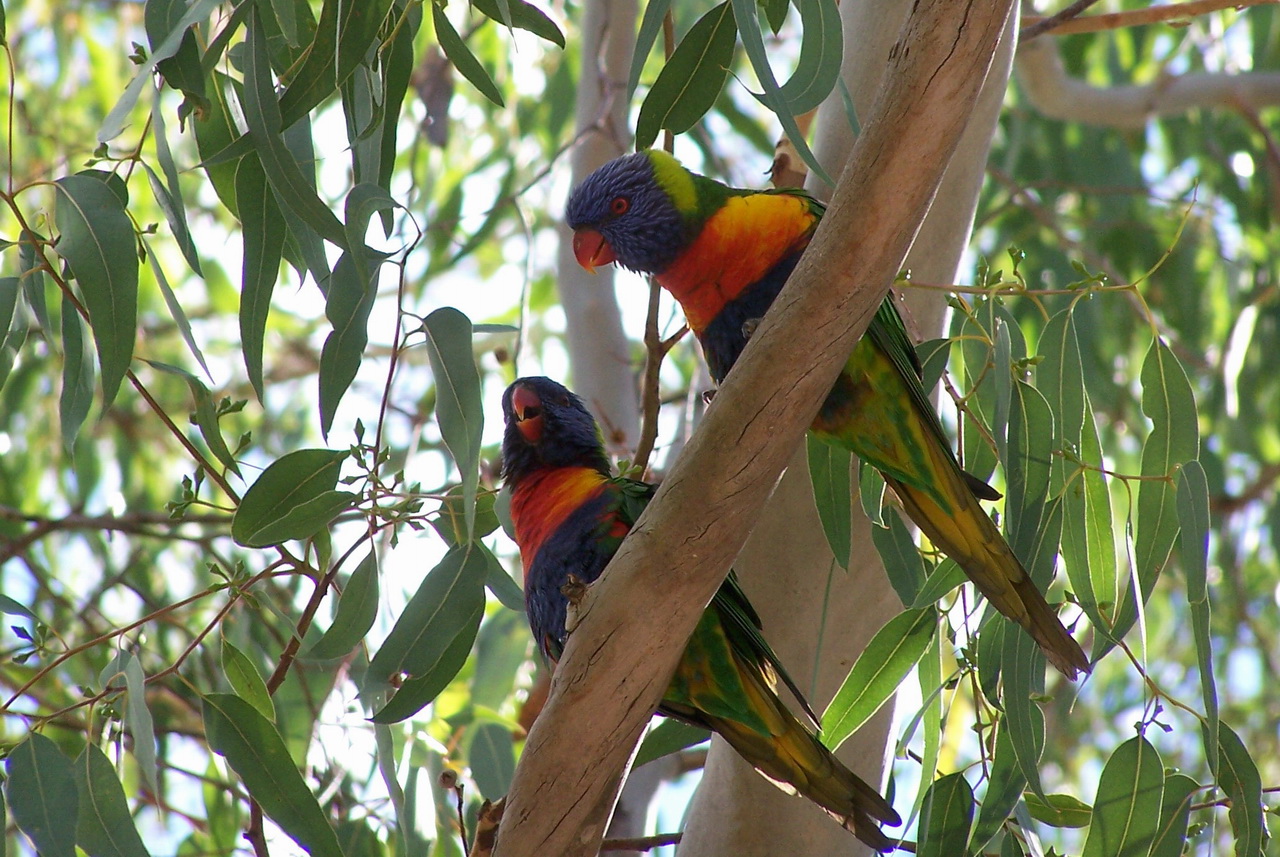Rainbow Lorikeet (Trichoglossus haematodus) - Wiki Rainbow Lorikeet
From Wikipedia, the free encyclopedia
[Photo] Wild Rainbow Lorikeets at Perry Lakes, Western Australia. "Photo taken and Uploaded by myself, Gnangarra 3rd April 2006. Trichoglossus haematodus, Rainbow Lorikeets at Perry Lakes Western Australia. Though a protected bird on the East Coast of Australia the Rainbow Lorikeet in WA the bird is calssed as a pest, it is subject to a major cull in an attempt to drastically reduce/erradicate their numbers. The rainbow lorikeet was accidentally release by ground staff at the University of Western Australia during the 1960's and have spread across the metropolitan area of Perth and as far inland as York-Beverley area diplacing the native species of Australian ringneck." Photo by Gnangarra http://commons.wikimedia.org/wiki/User:Gnangarra
The Rainbow Lorikeet, Trichoglossus haematodus is a species of Australasian parrot found in Australia, eastern Indonesia, Papua New Guinea, New Caledonia, Solomon Islands and Vanuatu. In Australia, it is common along the eastern seaboard, from Queensland to South Australia and northwest Tasmania. Its habitat is rainforest, coastal bush and woodland areas.
Rainbow Lorikeets have been introduced to Perth, Western Australia, Auckland, New Zealand and Hong Kong.
Description
Rainbow Lorikeets grow to 25-30 cm (9.8-11.8 in) in size, with a wingspan of about 17 cm (6.7 in) and vary significantly in coloration between the numerous subspecies. Their eponymous markings of the best known subspecies moluccanus are particularly striking: a dark blue or violet-blue head and stomach, a bright green back, tail and vent, and an orange breast and beak. Several have darker scalloped markings across the orange breast and the Weber's lorikeet is predominantly green.
Diet
Rainbow Lorikeets feed mainly on pollen and nectar, and possess a tongue adapted especially for their particular diet. The end of the tongue is equipped with a papillate appendage adapted to collecting nectar from flowers. They are also frequent visitors at bird feeders that supply lorikeet-friendly treats, such as store-bought nectar, sunflower seeds, and fruits such as apples, grapes and pears.
Reproduction
In Australia, breeding usually occurs during spring (September to December), and mated pairs typically nest in eucalypt tree hollows.
Aviculture
As with any parrot, ownership of lorikeets must not be taken lightly. Captive lorikeets have a long lifespan, often in excess of 20 years. Their diet makes them particularly messy; they are well-known in aviculture for their messy, liquid droppings and energetic nature. Captive-bred Rainbow Lorikeets are legal to own in Australia.
In many places, including campsites and suburban gardens, wild lorikeets are so used to humans that they can be hand-fed. The Currumbin Wildlife Sanctuary in Queensland, Australia, is noted for its numerous lorikeets, which number in the thousands. Around 8am and 4pm each day the birds gather in a huge, noisy flock in the park's main area. Visitors are encouraged to feed them a specially-prepared nectar, and the birds will happily settle on arms and heads to consume it. Wild Rainbow Lorikeets can also be hand-fed by visitors at Lone Pine Koala Sanctuary in Brisbane, Queensland, Australia.
Rainbow Lorikeets can also be fed in many zoos and animal parks outside Australia.
http://en.wikipedia.org/wiki/Rainbow_Lorikeet
| The text in this page is based on the copyrighted Wikipedia article shown in above URL. It is used under the GNU Free Documentation License. You may redistribute it, verbatim or modified, providing that you comply with the terms of the GFDL. |
